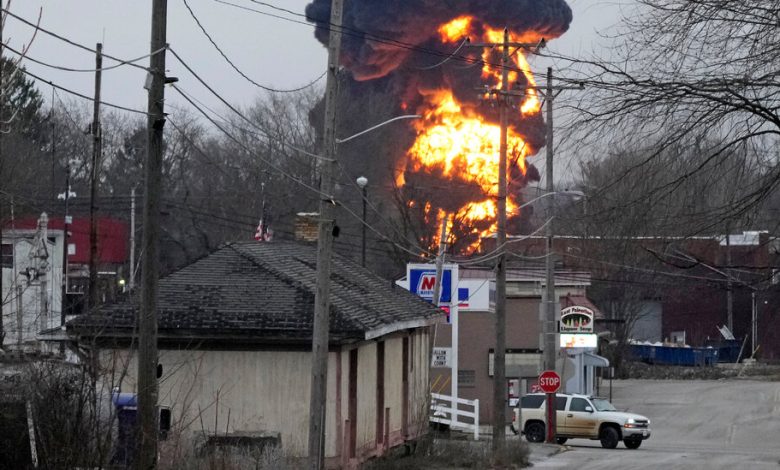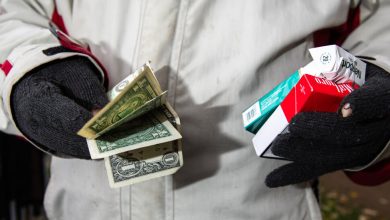A Deadly Chemical Was Released in the Ohio Train Derailment. It Should Be Banned.

Like a scene out of some postapocalyptic movie, Gov. Mike DeWine of Ohio convened a news conference on Feb. 5 to deliver a stark warning. “We are ordering them to leave,” he said of residents of the small rural community of East Palestine, Ohio, and a neighboring part of Pennsylvania. “This is a matter of life and death.” To emphasize the point, he added: “Those in the red area are facing grave danger of death if they are still in that area.”
In this case, the “grave danger of death” was not a zombie fungus or lethal bacteria but chemicals. The red area was an area one mile by two miles surrounding the town, on the Ohio-Pennsylvania border about 40 miles northwest of Pittsburgh.
Two days earlier, it was the site of a fiery derailment of train cars carrying the gas vinyl chloride and other chemicals. Freight trains typically transport more than two million carloads of hazardous materials each year, including many chemicals. Vinyl chloride is particularly dangerous and increasingly common, used primarily to make polyvinyl chloride, better known as PVC, a hard plastic resin used to produce pipes, wire, cable coatings and packaging. We should begin phasing out the use of this chemical.
It was a particular concern in East Palestine after the derailment. Because vinyl chloride is so flammable, it created a risk of an explosion that could launch deadly shrapnel as far as a mile. To avoid such a catastrophe, railroad officials vented the vinyl chloride and burned it off.
But shrapnel wasn’t the only risk. Inhaling vinyl chloride fumes can be deadly. Even people in neighboring towns were at risk. On Feb. 10, seven days after the crash, the Environmental Protection Agency said that chemicals were “known to have been and continue to be” released to the air, surface soil and surface waters.
Residents complained last week of rashes, headaches and a lingering odor. Thousands of dead fish turned up in streams near the crash site.
Vinyl chloride is not just suspected of causing cancer. The International Agency for Research on Cancer considers it a Group 1 carcinogen known to cause liver cancer in highly exposed industrial workers. It has also been associated with brain and lung cancers, lymphoma and leukemia.
We need to stop producing and using vinyl chloride and its most important end product, PVC plastics. Increasingly, major businesses are phasing it out. Many European communities have banned or restricted its use, even as the PVC plastics industry is expanding.
The United States should begin eliminating PVC by categories of use. Legislation has been floated in California to prohibit PVC in food packaging — a ban that could be expanded to other nonessential needs. Though PVC is inexpensive, it is replaceable in most cases. Alternatives include glass, ceramics, linoleum, polyesters and more.
Also, discarded PVC should be labeled a hazardous waste. The designation would put the burden on users for its safe storage, transportation and disposal, creating an incentive to accelerate its elimination. The E.P.A. tentatively rejected such an action in January but is still accepting public comment on the proposal.
You might wonder why such a hazardous chemical, among others, is being transported along American railways and through our communities. It’s because vinyl chloride is one of the most produced petrochemicals in the world.Tens of millions of tons of it are manufactured annually. (It was used as an aerosol propellant in household consumer products like hair spray until it was banned in aerosols by the Consumer Product Safety Commission in 1974.)
Vinyl chloride manufacturers laid the groundwork for the chemical’s proliferation decades ago with cover-ups and disinformation campaigns. Their own research showed that exposure led to deadly cancers in rodents. Numerous studies have found that workers regularly exposed to the chemical during the 1970s developed malignant liver cancers at very high rates. Chemical companies knew early on they were unleashing a dangerous substance into the world.
The extraordinary efforts of the chemical industry to continue selling products it knew were harmful were recounted by two of us in our 2002 book “Deceit and Denial.”
In addition to the manufacturing and transportation risks of vinyl chloride, PVC plastics can release endocrine-disrupting phthalates, used to soften PVC, and cancer-causing dioxins into air and water during much of their life cycle.
Many of the vinyl chloride and PVC production facilities are clustered with other petrochemical facilities along an 85-mile stretch of the Mississippi River in Louisiana between Baton Rouge and New Orleans known as





